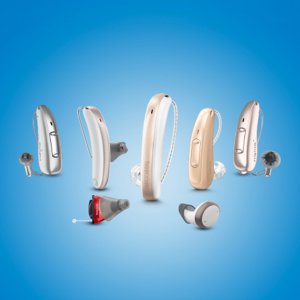
Behind-the-ear hearing aids
Powerful and inconspicuous
Behind-the-ear hearing (BTE) aids are the best known hearing aid form factor. These hearing aids are very small, light and when seated behind your ear, are virtually invisible. BTE hearing aids are suitable for almost all hearing losses.
Behind-the-ear hearing aids are available in different colors to match your hair and skin color or even express your style. They’re also available with multiple functions that can help you personalize your hearing aid to your lifestyle.
Table of Contents
- Behind-the-ear hearing aids (BTE)
- BTE hearing aids with an external receiver
- BTE hearing aids with sound tubes
Behind-the-ear hearing aids are suitable for almost all hearing losses. They are available in different colors and in two versions:
- BTE with external earpiece: For mild to moderate hearing loss, sound is conducted through a barely visible cable into the “earpiece” in the ear canal
- BTE with sound tube: For severe hearing losses, sound is fed through a tube into the ear mold
BTE hearing aids with an external receiver

These hearing aids are particularly popular with first-time buyers. They are the most discreet form of BTE hearing aids and are characterized by their high level of comfort. The amplified signal is passed through a hair-thin, barely visible cable into the “receiver”. The “listener” sits in the ear canal just in front of the eardrum, ie “external” / outside the hearing aid housing. A small fixing screen or an individual earmold supports the position of the “listener”.
A clear and natural speech quality is achieved, i.e. one’s own voice and environmental noises are perceived more naturally. The advantage here is that the ear usually only closes off to an insignificant extent and the ear canal remains pleasantly free and open so that it is well ventilated. The fact that a thin hearing tube establishes a direct connection between the hearing aid and the eardrum also ensures particularly high sound quality.
BTE hearing aids with sound tubes

These hearing aids are commonly used for more severe hearing loss. They are comfortable to wear in those cases where very high hearing aid performance is required. The sound passes through a tube into an individual earmold, which is precisely adapted to the wearer’s ear. The housing, which is larger than the BTE hearing aid with an external receiver, contains a more powerful amplifier as well as a larger battery.
Nowadays, extensive color and shape combinations enable optically very discreet hearing systems, even in this high-performance area. Compared to in-the-ear hearing aids, behind-the-ear hearing aids tend to be more comfortable to wear, have a more natural perception of speech and sounds, and are easier to use on a day-to-day basis.





